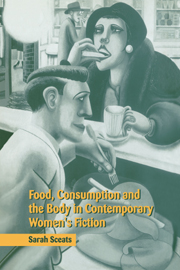Book contents
- Frontmatter
- Contents
- Acknowledgements
- Introduction
- Chapter 1 The food of love: mothering, feeding, eating and desire
- Chapter 2 Cannibalism and Carter: fantasies of omnipotence
- Chapter 3 Eating, starving and the body: Doris Lessing and others
- Chapter 4 Sharp appetites: Margaret Atwood's consuming politics
- Chapter 5 Food and manners: Roberts and Ellis
- Chapter 6 Social eating: identity, communion and difference
- Conclusion
- Notes
- Bibliography
- Index
Chapter 1 - The food of love: mothering, feeding, eating and desire
Published online by Cambridge University Press: 22 September 2009
- Frontmatter
- Contents
- Acknowledgements
- Introduction
- Chapter 1 The food of love: mothering, feeding, eating and desire
- Chapter 2 Cannibalism and Carter: fantasies of omnipotence
- Chapter 3 Eating, starving and the body: Doris Lessing and others
- Chapter 4 Sharp appetites: Margaret Atwood's consuming politics
- Chapter 5 Food and manners: Roberts and Ellis
- Chapter 6 Social eating: identity, communion and difference
- Conclusion
- Notes
- Bibliography
- Index
Summary
Food is a currency of love and desire, a medium of expression and communication. The crucial centrepiece of Christian worship is a simulated meal – the giving of symbolic bread and wine as a token of love and trust – and in most religions ritual communicative eating of some sort is prominent. From infants' sticky offerings to anniversary chocolates, from shared school lunch boxes to hospital grapes, the giving of food is a way of announcing connection, goodwill, love. For friends, food may be an expression of support or an invitation to celebrate; for lovers there is an intimate, sexual subtext, appetite incorporated into sexuality. In the all-important sphere of mothering, food-giving is a matter of routine; nurturing depends on repeated and regular care and feeding rather than the occasional spontaneous act and is, in theory at least, essentially altruistic.
For many people the connection of food with love centres on the mother, as a rule the most important figure in an infant's world, able to give or withhold everything that sustains, nourishes, fulfils, completes. It is this person who shapes or socialises a child's appetite and expectations of the world, by feeding on demand or adhering to a rigid schedule, by the cultivation of ‘table manners’, through the provision of fish fingers or porridge, raw fish or curry.
- Type
- Chapter
- Information
- Publisher: Cambridge University PressPrint publication year: 2000



